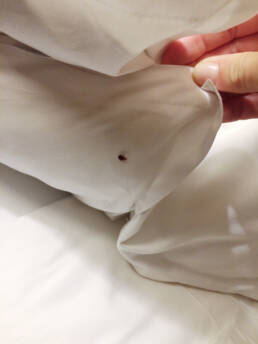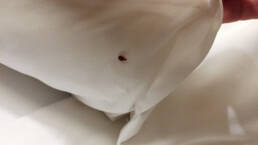Heat Extermination Is 100% Effective! You will encounter conflicting information on the internet and also from competing companies claiming the usual stuff – their system is the best, and the one and only and the other guy is of course no good or dangerous or perhaps something vaguely indeterminate and nasty. This page offers actual explanations of the different heat treatment systems out there so that you can decide for yourself. The truth is that each heat treatment system can be used safely and effectively so if you are comfortable with the company and you trust them, the system they use matters less than how they use it.
Electrical Extermination Systems
These are the most common with at least 6 different manufacturers offering bed bug-specific heaters, all of which work. Power for the heaters is typically generated outside by a diesel-fueled generator, cabling is run into the building and distributes the power to the heaters, which are placed inside the space to be heated. Some models of heater can also be powered off of building power. Hot Bugz has both heat systems and can heat above 135 degrees when required. Some electrical systems shut off at 135 degrees.
Hot Bugz has found that there are times when temperatures need to go higher. These systems allow heat treatments in high-rise towers as the cable is relatively easy to run up multiple floors, and some of them come as a complete start-up kit with everything you need. Drawbacks of electrical systems are that the heaters are often underpowered, the systems are not scalable (you cannot do a large house or multiple apartment units at the same time), and the industry-leading trailer package that most people buy is quite expensive and therefore keeps costs to clients quite high as well. Hot Bugz has a custom-designed electrical heating system that allows us to do heat treatments anywhere in a high-rise tower.
Forced Air Extermination Systems
These come in several forms, direct and indirect, fueled by either diesel or propane.
Indirect Fired
In this scenario the heater is parked outside and clean, dry, hot air is pumped into the space to be heated with ducting running from the heater. The exhaust fumes from the combustion of the fuel stay outside. The benefits of these systems is that they generate vastly more heat than electrical systems and they are highly scalable – large homes and multiple apartment units can be done all in the same day and therefore treatment times and costs are kept down. The drawback of this system is that they are only useful on buildings 3 floors in height or lower as the hot air cannot be pumped higher. At Hot Bugz we use indirect fired diesel fueled systems because they are efficient and economical and highly scalable (and we use our electrical system for the 4th floor or higher).
Direct Fired
These heaters are also parked outside and the hot air is run in through ducting. The drawback of these systems is that the particles of combustion (the exhaust) are also pumped inside the heated space. When propane is used as the fuel a significant amount of moisture is also pumped inside. These issues can be dealt with if the company is diligent and knows what it is doing. This is a very common method of remediation in the US and it has the longest track record of use for pest management (having been used safely for many years against food pests in grain silo’s and commercial food processing facilities, and against termites in the Southern US). This method is not used by Assured Thermal Solutions. Most negative comments coming from companies that only sell or use electrical systems are typically aimed at direct-fired propane-fueled systems.
The highest risk method that we do not use or endorse is the use of construction-style propane-fueled direct-fired heaters being placed inside the space to be heated. This has resulted in several fires in the United States (and one in Edmonton causing several million dollars in damage).
Hydronic (Glycol) Extermination Systems
In this scenario, diesel is burned to heat a tank of glycol which is then pumped through high-pressure hoses into the building. The hot glycol is run through heat exchangers (the heaters) which are parked inside the rooms to be heated. The glycol is then recirculated back outside to the tank to be re-heated and pumped back inside. These systems are very effective and have been pioneered in Winnipeg, Manitoba. The drawbacks of these systems are that the equipment is very expensive and hard to scale up (additional pumps and hoses are needed to go above three stories). At this point, no one in our industry offers this system to our knowledge.
Steam and Freezing Methods
Both have a lower success rate because you have to know the location of every bug and egg for it to be successful.
At Hot Bugz we know our industry, the various systems, and how they work and we can bring whatever system is most appropriate to solve your bed bug problem. We also aim to educate and inform in everything we do to help people be comfortable in their choices and make the best decision possible.

Ready for an expert opinion? Get in touch today!
We kill bed bugs in the infested space and surrounding walls by heating the space to a temperature of 135°F, killing all bed bugs and their eggs. If you have a bed bug problem, we have a solution. Exterminate bed bugs today with Hot Bugz. It’s safe and you get to keep your stuff. Call us today for a free consultation.
Like this article? Spread the word!
Related Posts
July 10, 2024
Banish Bed Bugs with Hot Bugz: Your Trusted Front Range Exterminator
Discover effective bed bug extermination with Hot Bugz, the premier Front Range bed bug…
December 8, 2023
Understanding What to Do When Bed Bug Treatments Don’t Work
Hot Bugz in Denver, CO offers comprehensive bed bug extermination services. From…
October 27, 2023
Back to School: Protecting Your Child from Bed Bugs
Discover essential tips and tricks for a bed bug-free back-to-school season. Learn how to…





